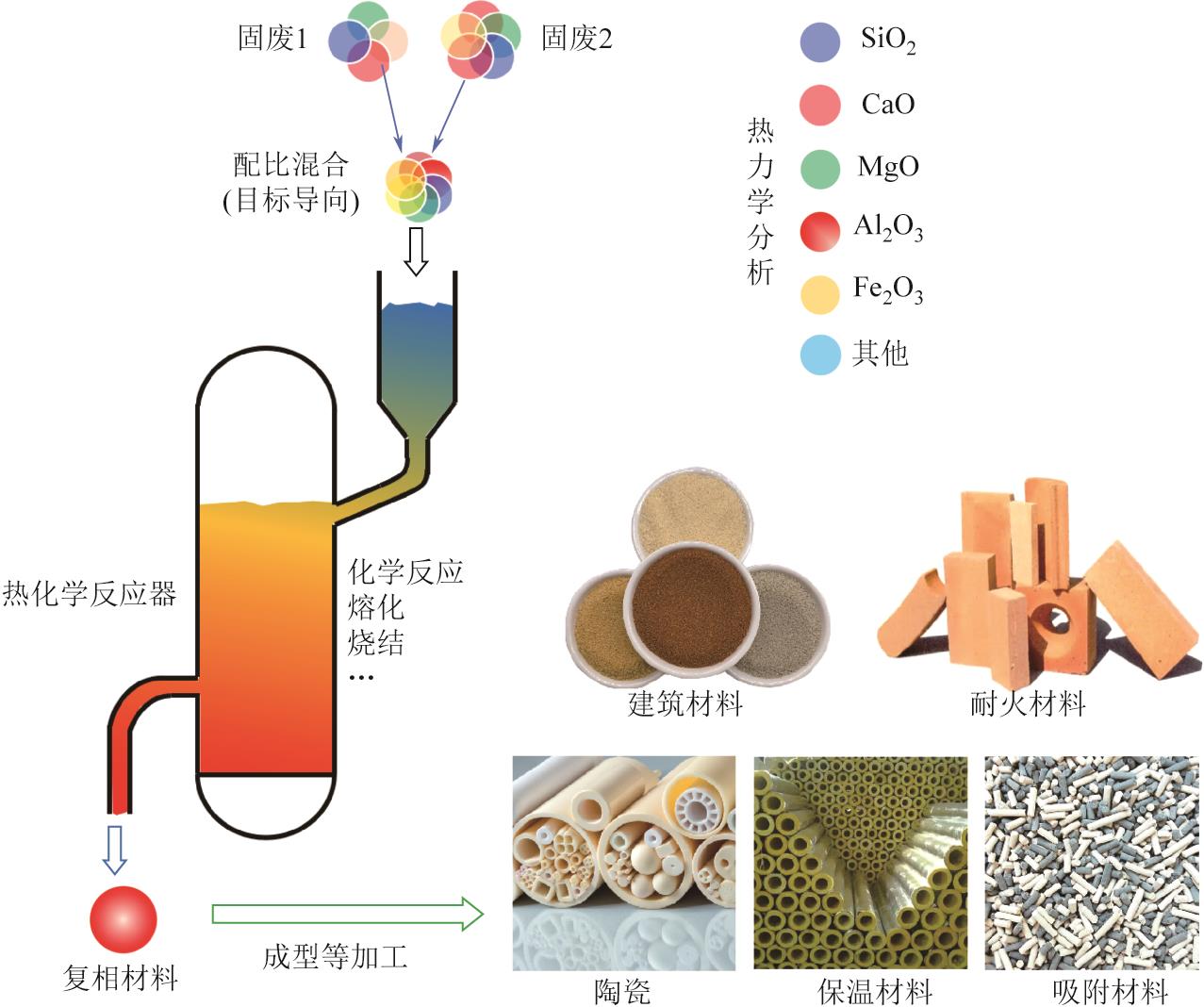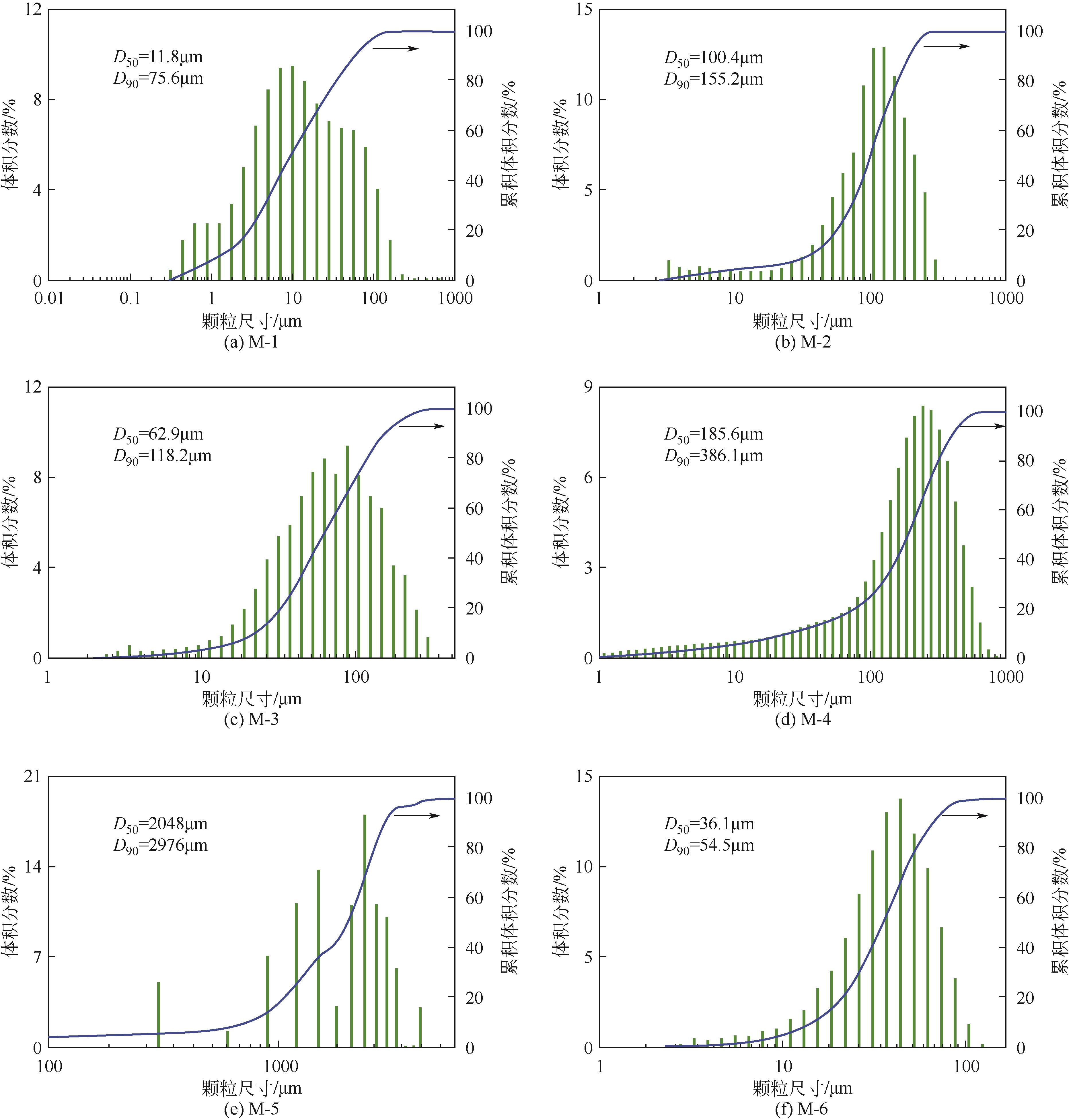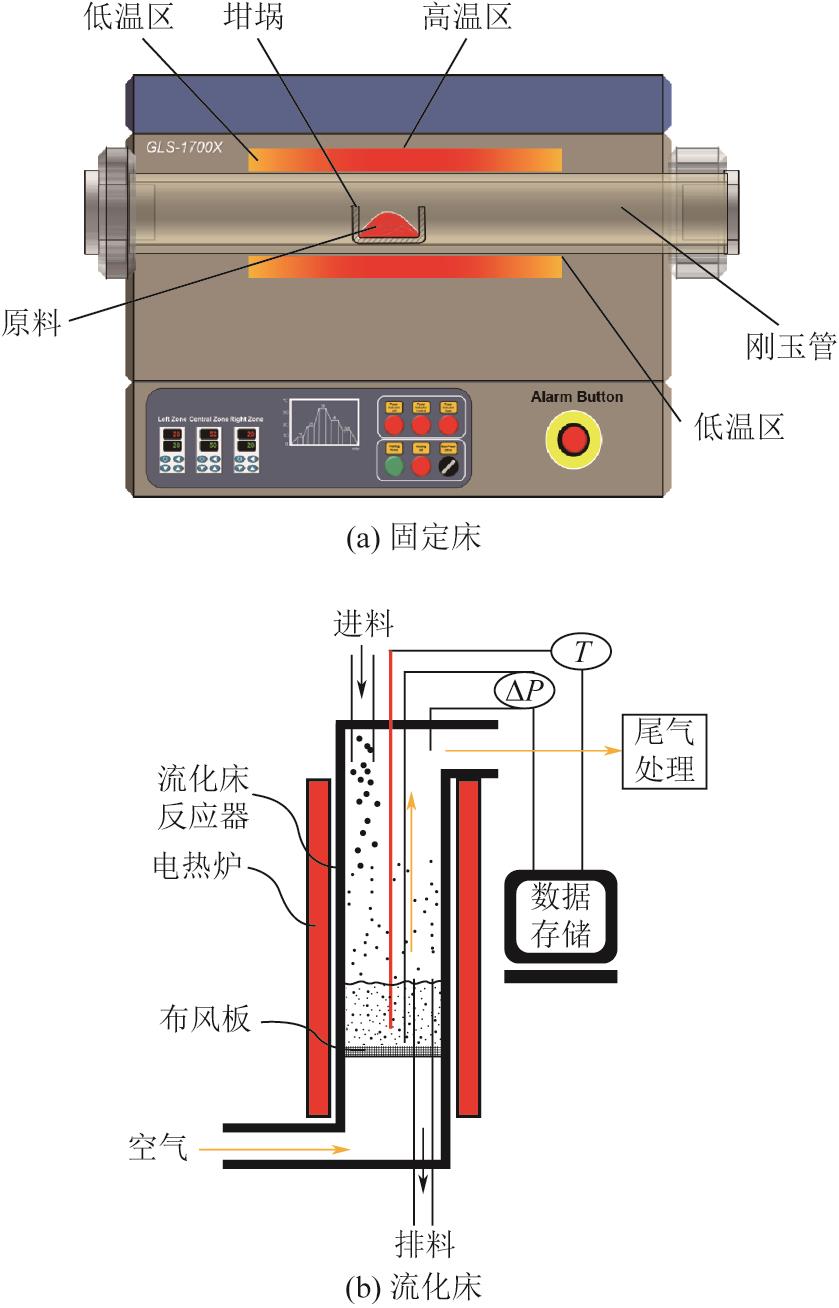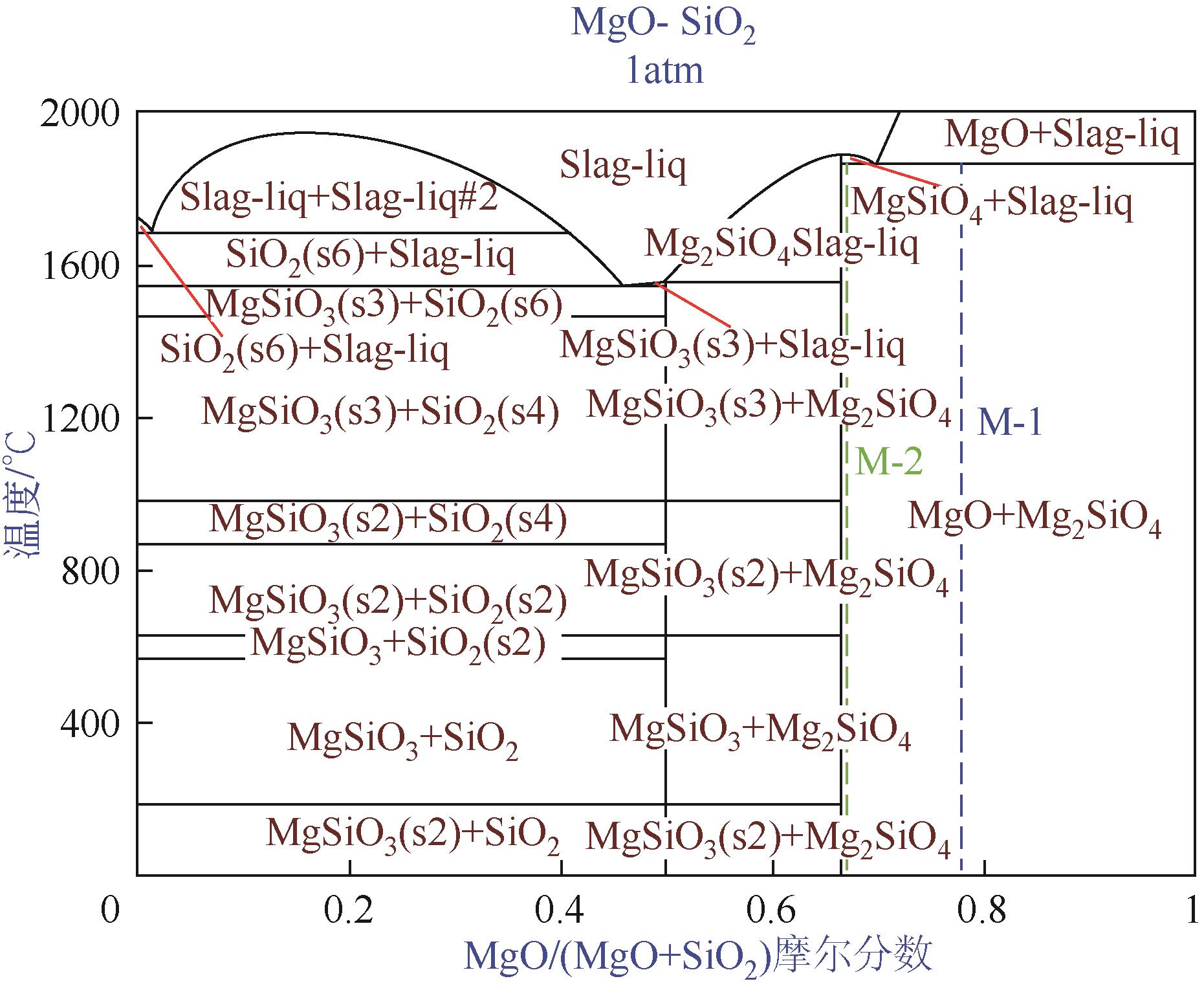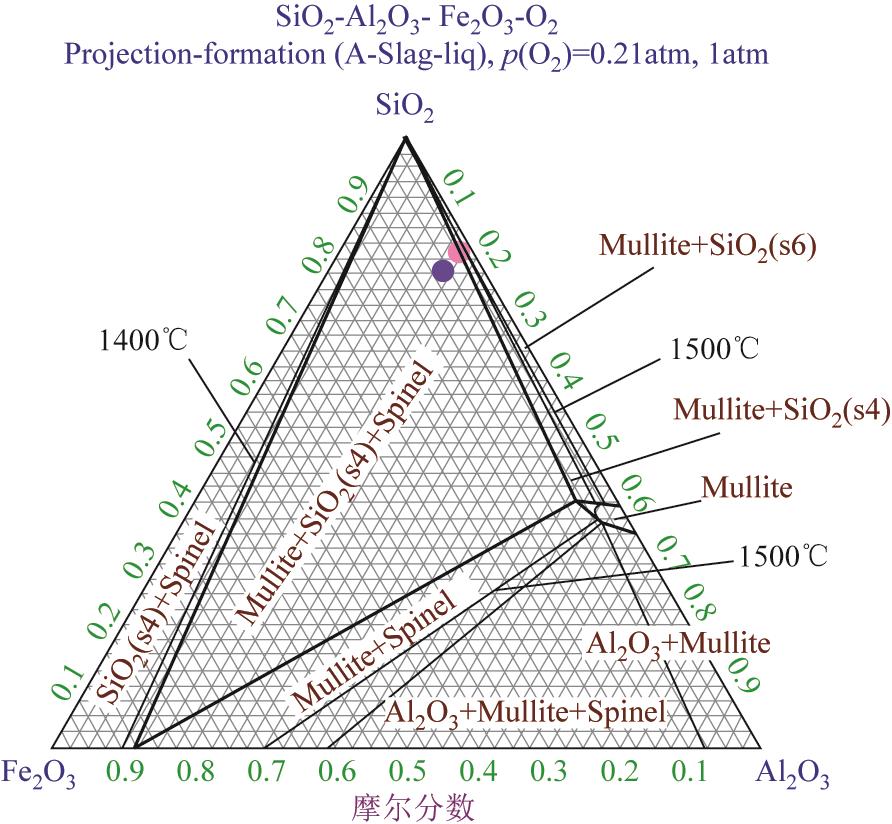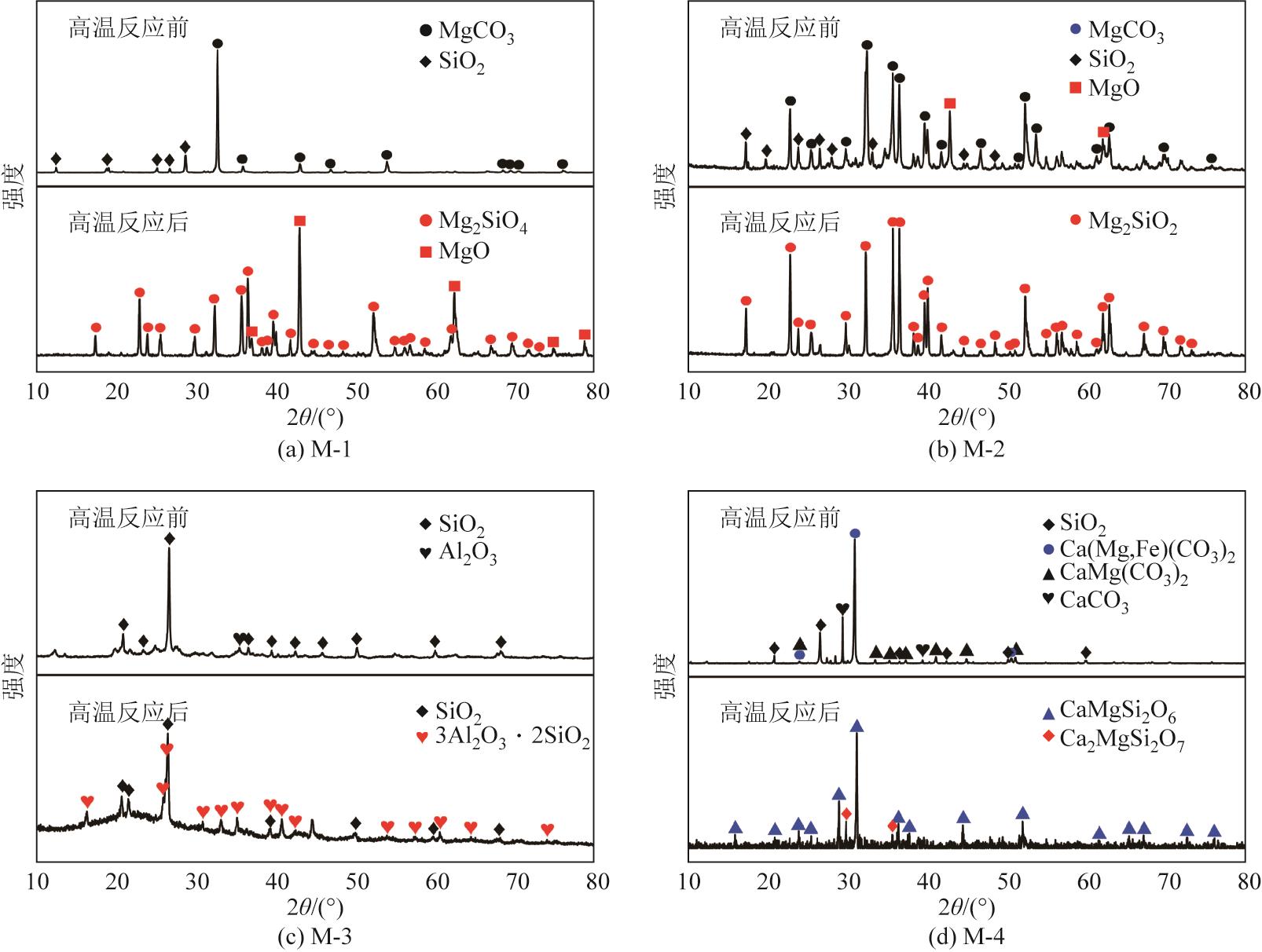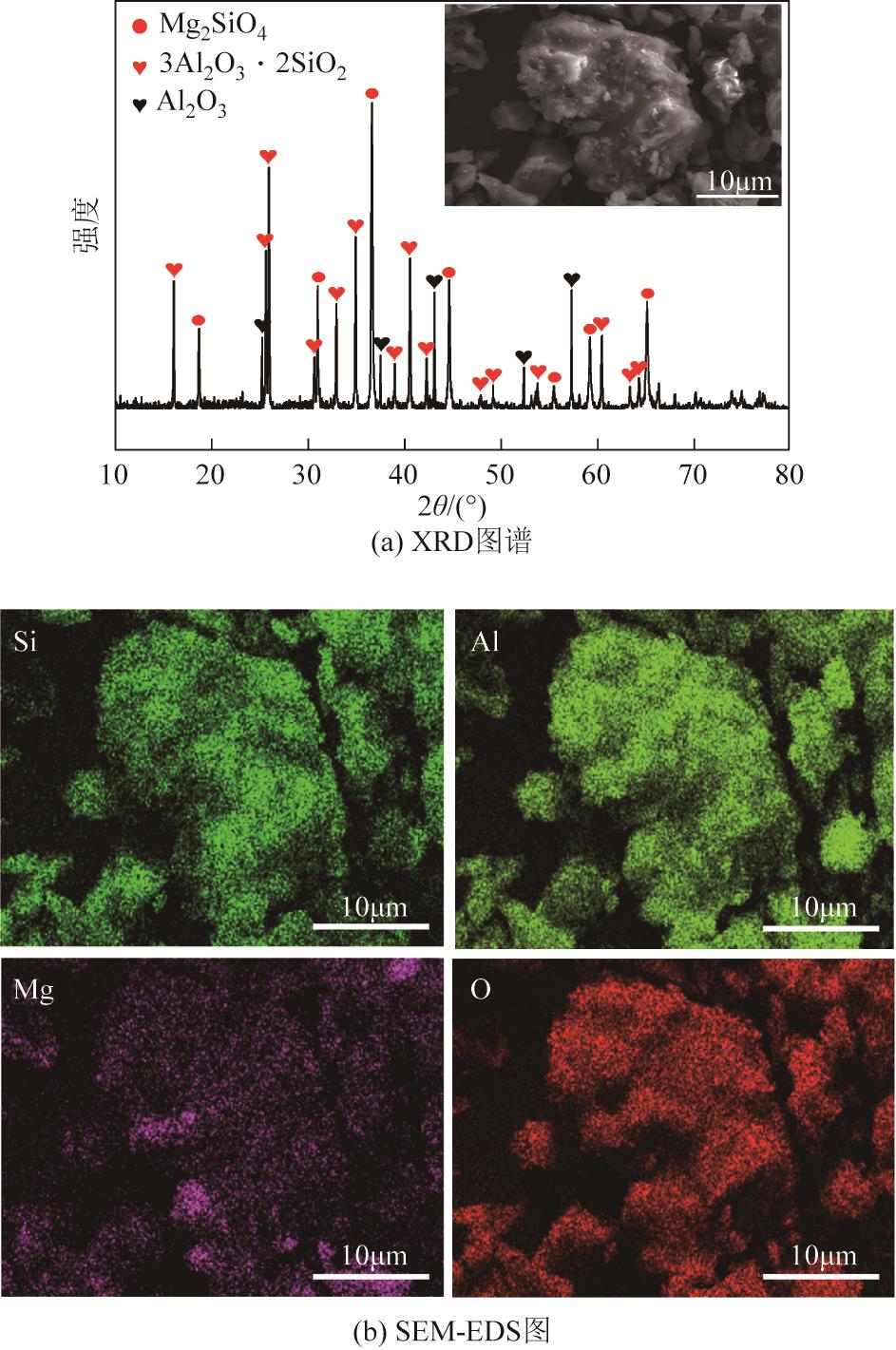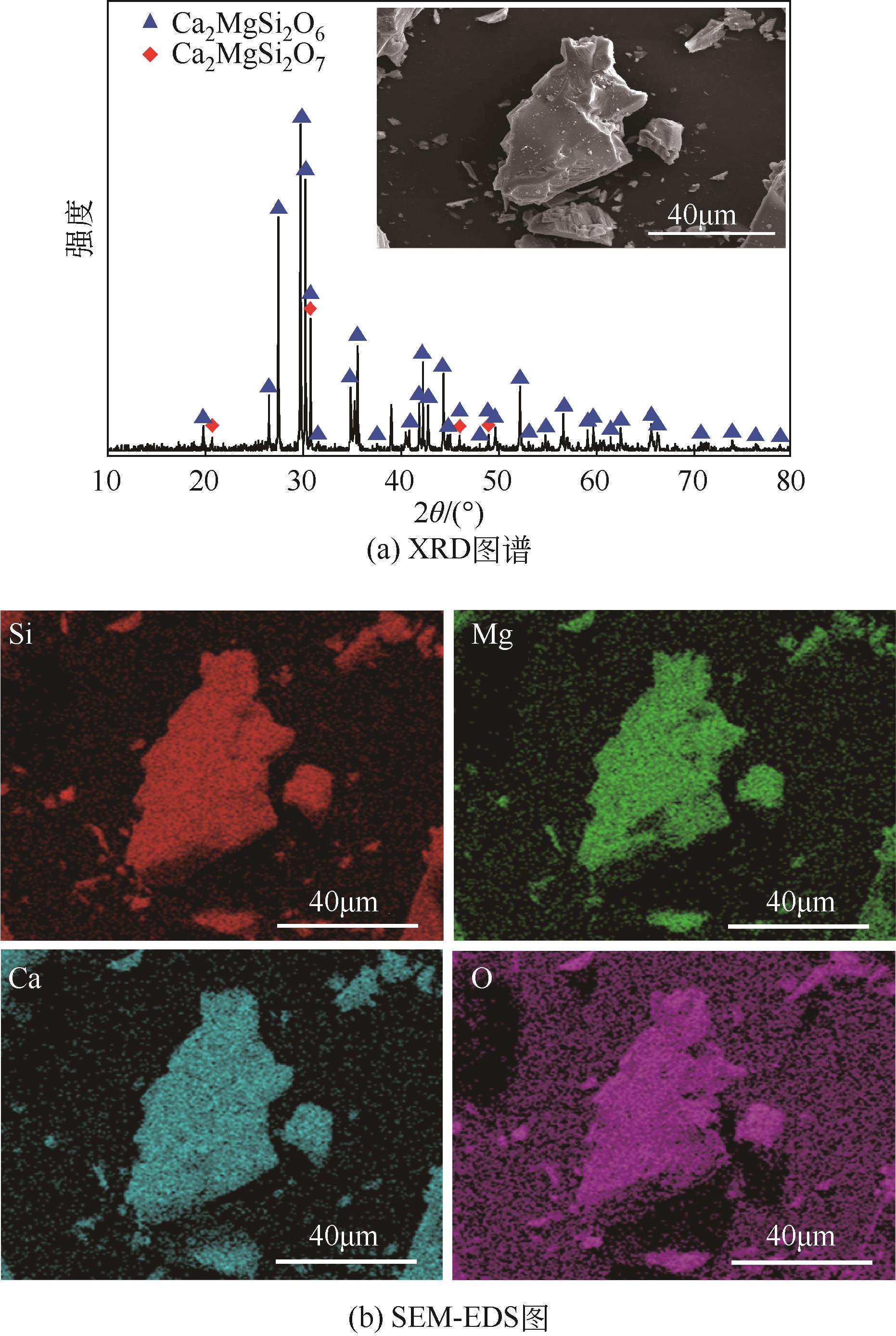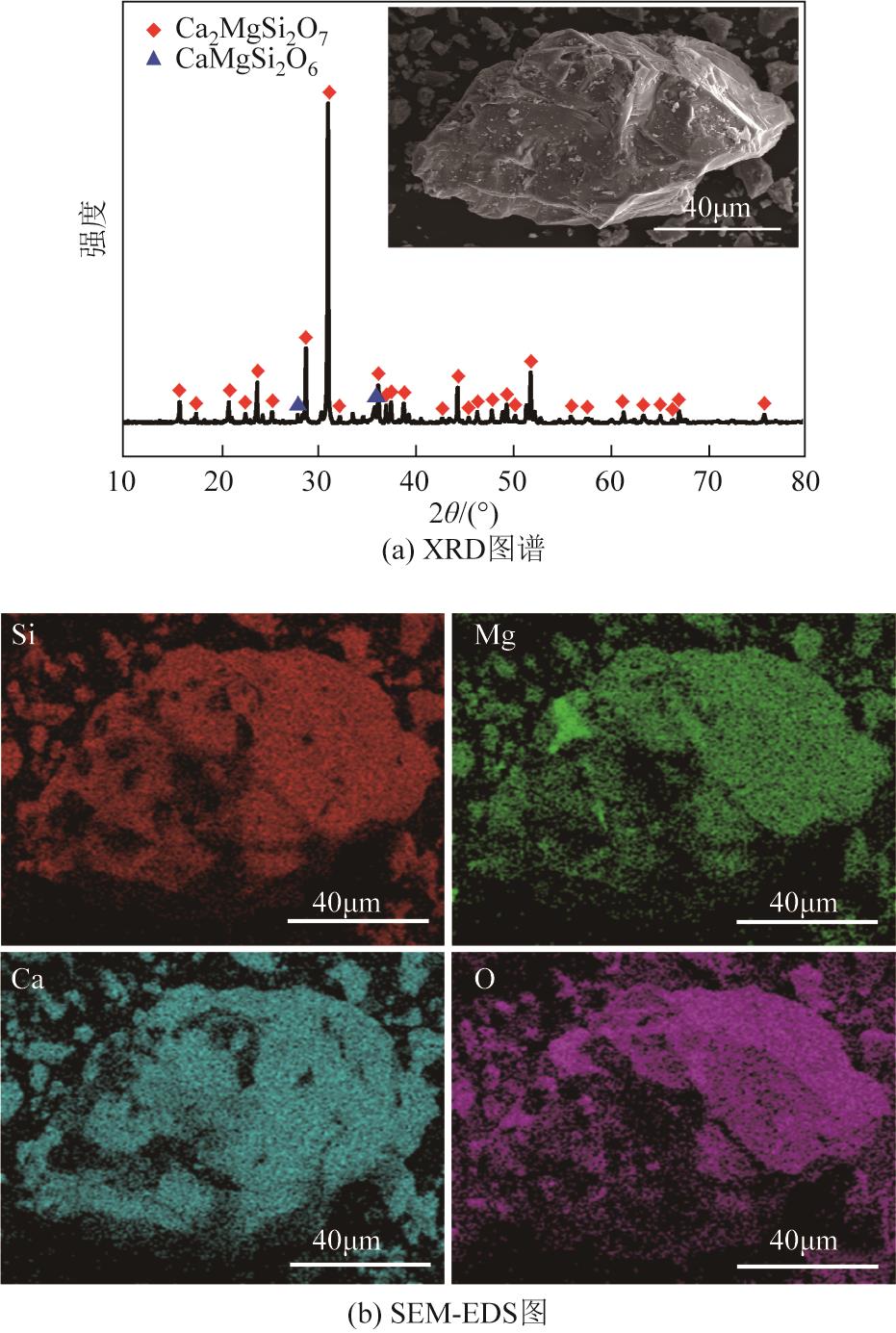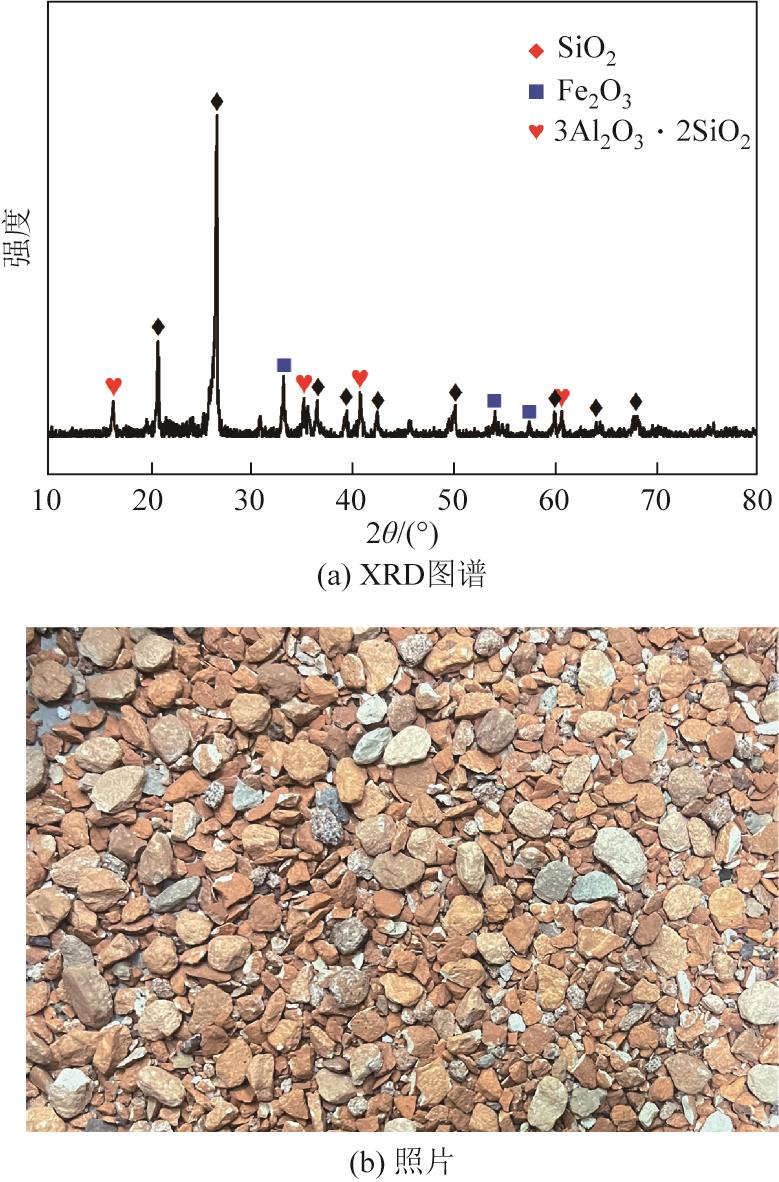化工进展 ›› 2024, Vol. 43 ›› Issue (7): 3756-3767.DOI: 10.16085/j.issn.1000-6613.2024-0598
• 专栏:热化学反应工程技术 • 上一篇
无机工业固体废弃物高温热化学转化的基础研究
邹旭( ), 付亮亮(
), 付亮亮( ), 胡枋伶, 宋佳, 高佳辉, 张庆瑾, 许光文, 白丁荣(
), 胡枋伶, 宋佳, 高佳辉, 张庆瑾, 许光文, 白丁荣( )
)
- 沈阳化工大学特色资源化工与材料教育部重点实验室,辽宁 沈阳 110142
-
收稿日期:2024-04-10修回日期:2024-04-30出版日期:2024-07-10发布日期:2024-08-14 -
通讯作者:付亮亮,白丁荣 -
作者简介:邹旭(2000—),女,硕士研究生,研究方向为固废处理技术。E-mail:jixiezouxu@163.com -
基金资助:国家自然科学联合基金重点项目(U22A20410)
Basic research on high-temperature thermochemical reactions of industrial inorganic solid waste
ZOU Xu( ), FU Liangliang(
), FU Liangliang( ), HU Fangling, SONG Jia, GAO Jiahui, ZHANG Qingjin, XU Guangwen, BAI Dingrong(
), HU Fangling, SONG Jia, GAO Jiahui, ZHANG Qingjin, XU Guangwen, BAI Dingrong( )
)
- Key Laboratory on Resources Chemicals and Material of Ministry of Education, Shenyang University of Chemical Technology, Shenyang 110142, Liaoning, China
-
Received:2024-04-10Revised:2024-04-30Online:2024-07-10Published:2024-08-14 -
Contact:FU Liangliang, BAI Dingrong
摘要:
随着工业的持续发展,煤、油页岩、菱镁矿、铁矿等矿物资源的用量不断增加,产生大量无机工业固体废弃物,低效的固废处置方式造成了巨大的环境污染和资源浪费。基于常见典型工业固体废弃物的化学组成,结合热力学分析结果,提出一种工业固体废弃物高温热化学转化方法,直接将无机工业固体废弃物转化为高附加值材料。该高温热化学转化方法通过热力学分析确定理想的目标产物及反应温度,利用热质传递效率高和易于放大的流化床,使单一或多种固体废弃物混合物中的各化学成分间发生固-固高温热化学反应,制成所需的复相材料使用或经进一步加工制得具有更高附加值的终端产品。通过对菱镁矿浮选尾矿、硼泥、油页岩渣、铁尾矿、铝灰、煤矸石等多种固体废弃物实验,获得了相应的复相粉体材料,验证了该方法的可行性。同时,通过选择性混合多种固体废弃物,改变反应物组成,可以调控目标产物及其含量。实验结果表明,利用高温流态化热化学反应技术,无机工业固体废弃物可成功转化为高附加值产物。研究成果对实现无机工业固体废弃物的有效利用、减少资源浪费、保护生态环境、推动绿色、低碳和可持续发展提供了又一途径,也为相关固体废弃物的综合利用提供了具体数据支撑。
中图分类号:
引用本文
邹旭, 付亮亮, 胡枋伶, 宋佳, 高佳辉, 张庆瑾, 许光文, 白丁荣. 无机工业固体废弃物高温热化学转化的基础研究[J]. 化工进展, 2024, 43(7): 3756-3767.
ZOU Xu, FU Liangliang, HU Fangling, SONG Jia, GAO Jiahui, ZHANG Qingjin, XU Guangwen, BAI Dingrong. Basic research on high-temperature thermochemical reactions of industrial inorganic solid waste[J]. Chemical Industry and Engineering Progress, 2024, 43(7): 3756-3767.
| 作者 | 主要原料 | 反应条件 | 样品形状 | 存在问题 |
|---|---|---|---|---|
| 丁达飞等[ | 菱镁矿浮选尾矿 | 1500℃、5h | 长方体 | 产品晶体发育较好,但传热效率慢,有1.7%~5.4%(质量分数)的MgO未转化 |
| 罗玉萍等[ | 硼泥、镁砂 | 1500℃、8h | 圆柱试样 | 制备时间较长,产品中有低熔点杂质,对产品性能有不利影响 |
| 李静等[ | 高硅铁尾矿、高镁原料 | 1500~1600℃、4~6h | 圆柱试样 | 反应温度较高、时间较长,耗能较高 |
| 李振等[ | 菱镁矿浮选尾矿、硼泥、硅石 | 1550℃、3h | 压块 | 硼泥中的Fe2O3等杂质降低镁橄榄石的纯度和共熔点,影响了材料的耐火性能 |
| 刘吉辉等[ | 铁尾矿、轻烧镁粉 | 1527℃、2h | 圆柱试样 | 随着温度的升高生成低熔点的铁橄榄石,降低了耐火材料性能 |
| 王素等[ | 高镁型铁尾、矿轻烧镁砂、电熔镁砂 | 1500℃、6h | 圆柱试样 | 需要对制得的产品进行二次磨细,造成人工损耗且反应时间较长能耗高 |
| 姚文贵等[ | 铝土尾矿 | 1600℃、3h | 圆柱试样 | Fe2O3、TiO2、K2O、CaO等杂质降低了产品耐火性能 |
| 王新锋等[ | 铝型材厂污泥、叶腊石 | 1600℃、3h | 压块 | 试样强度较低、热稳定性较差 |
| 张倩[ | 粉煤灰、煤矸石、铝灰 | 1200℃、10h | 圆柱试样 | 传热效率较低,反应时间较长,耗能较高 |
| 周萍等[ | 菱镁矿尾矿、二次铝灰 | 1400℃、3h | 圆柱试样 | 制备的产品显气孔率较高,降低了复相材料的强度和硬度 |
表1 高温处理工业无机固体废弃物的应用或研究
| 作者 | 主要原料 | 反应条件 | 样品形状 | 存在问题 |
|---|---|---|---|---|
| 丁达飞等[ | 菱镁矿浮选尾矿 | 1500℃、5h | 长方体 | 产品晶体发育较好,但传热效率慢,有1.7%~5.4%(质量分数)的MgO未转化 |
| 罗玉萍等[ | 硼泥、镁砂 | 1500℃、8h | 圆柱试样 | 制备时间较长,产品中有低熔点杂质,对产品性能有不利影响 |
| 李静等[ | 高硅铁尾矿、高镁原料 | 1500~1600℃、4~6h | 圆柱试样 | 反应温度较高、时间较长,耗能较高 |
| 李振等[ | 菱镁矿浮选尾矿、硼泥、硅石 | 1550℃、3h | 压块 | 硼泥中的Fe2O3等杂质降低镁橄榄石的纯度和共熔点,影响了材料的耐火性能 |
| 刘吉辉等[ | 铁尾矿、轻烧镁粉 | 1527℃、2h | 圆柱试样 | 随着温度的升高生成低熔点的铁橄榄石,降低了耐火材料性能 |
| 王素等[ | 高镁型铁尾、矿轻烧镁砂、电熔镁砂 | 1500℃、6h | 圆柱试样 | 需要对制得的产品进行二次磨细,造成人工损耗且反应时间较长能耗高 |
| 姚文贵等[ | 铝土尾矿 | 1600℃、3h | 圆柱试样 | Fe2O3、TiO2、K2O、CaO等杂质降低了产品耐火性能 |
| 王新锋等[ | 铝型材厂污泥、叶腊石 | 1600℃、3h | 压块 | 试样强度较低、热稳定性较差 |
| 张倩[ | 粉煤灰、煤矸石、铝灰 | 1200℃、10h | 圆柱试样 | 传热效率较低,反应时间较长,耗能较高 |
| 周萍等[ | 菱镁矿尾矿、二次铝灰 | 1400℃、3h | 圆柱试样 | 制备的产品显气孔率较高,降低了复相材料的强度和硬度 |
| 编号 | 原料名称 | CaO | SiO2 | MgO | Fe2O3 | Al2O3 | K2O | Cl | Na2O | 其他 |
|---|---|---|---|---|---|---|---|---|---|---|
| M-1 | 菱镁矿浮选尾矿 | 1.35 | 29.97 | 64.96 | 0.86 | 2.86 | — | — | — | — |
| M-2 | 硼泥 | 0.20 | 37.45 | 56.71 | 4.80 | 0.56 | — | — | 0.27 | 0.01 |
| M-3 | 油页岩渣 | 1.58 | 58.78 | 0.93 | 11.20 | 20.88 | 1.49 | — | 0.70 | 4.44 |
| M-4 | 铁尾矿 | 26.92 | 45.18 | 15.07 | 4.75 | 3.42 | 1.46 | 0.05 | 0.28 | 2.87 |
| M-5 | 煤矸石 | 0.83 | 63.09 | 0.76 | 4.73 | 22.97 | 3.57 | — | 1.74 | 2.31 |
| M-6 | 铝渣 | 1.58 | 3.05 | 9.17 | 0.35 | 60.96 | 0.73 | 12.64 | 8.82 | 2.70 |
表2 各原料的元素组成(质量分数,%)
| 编号 | 原料名称 | CaO | SiO2 | MgO | Fe2O3 | Al2O3 | K2O | Cl | Na2O | 其他 |
|---|---|---|---|---|---|---|---|---|---|---|
| M-1 | 菱镁矿浮选尾矿 | 1.35 | 29.97 | 64.96 | 0.86 | 2.86 | — | — | — | — |
| M-2 | 硼泥 | 0.20 | 37.45 | 56.71 | 4.80 | 0.56 | — | — | 0.27 | 0.01 |
| M-3 | 油页岩渣 | 1.58 | 58.78 | 0.93 | 11.20 | 20.88 | 1.49 | — | 0.70 | 4.44 |
| M-4 | 铁尾矿 | 26.92 | 45.18 | 15.07 | 4.75 | 3.42 | 1.46 | 0.05 | 0.28 | 2.87 |
| M-5 | 煤矸石 | 0.83 | 63.09 | 0.76 | 4.73 | 22.97 | 3.57 | — | 1.74 | 2.31 |
| M-6 | 铝渣 | 1.58 | 3.05 | 9.17 | 0.35 | 60.96 | 0.73 | 12.64 | 8.82 | 2.70 |
| 检测项目 | 细骨料指标要求 (JG/T568—2019,细骨料) | 检测 结果 | ||
|---|---|---|---|---|
| Ⅰ | Ⅱ | Ⅲ | ||
| 含泥量/% | ≤1.0 | ≤3.0 | ≤5.0 | 0.0 |
| 硫化物及硫酸盐含量/% | ≤0.5 | ≤0.5 | ≤0.5 | 0.0 |
| 泥块含量/% | ≤0.2 | ≤1.0 | ≤2.0 | 0.0 |
| 表观密度/kg·m-3 | ≥2500 | ≥2500 | ≥2500 | 2790 |
| 坚固性 | ≤8.0 | ≤8.0 | ≤10.0 | 4.7 |
| 压碎指标/% | ≤20 | ≤25 | ≤30 | 17 |
| 空隙率/% | ≤43 | ≤45 | ≤47 | 21 |
表3 M-5高温热转化产物的性能检测结果
| 检测项目 | 细骨料指标要求 (JG/T568—2019,细骨料) | 检测 结果 | ||
|---|---|---|---|---|
| Ⅰ | Ⅱ | Ⅲ | ||
| 含泥量/% | ≤1.0 | ≤3.0 | ≤5.0 | 0.0 |
| 硫化物及硫酸盐含量/% | ≤0.5 | ≤0.5 | ≤0.5 | 0.0 |
| 泥块含量/% | ≤0.2 | ≤1.0 | ≤2.0 | 0.0 |
| 表观密度/kg·m-3 | ≥2500 | ≥2500 | ≥2500 | 2790 |
| 坚固性 | ≤8.0 | ≤8.0 | ≤10.0 | 4.7 |
| 压碎指标/% | ≤20 | ≤25 | ≤30 | 17 |
| 空隙率/% | ≤43 | ≤45 | ≤47 | 21 |
| 1 | 中国统计出版社. 生态环境统计年报[R]. 2023. |
| China Statistics Press. Annual report of ecological and environmental statistics[R]. 2023. | |
| 2 | 再协. 2020年全国大、中城市固体废物污染环境防治年报[J]. 中国资源综合利用, 2021, 39(1): 4. |
| ZAI Xie. Annual report on prevention and control of environmental pollution by solid waste in large and medium-sized cities in China in 2020[J]. China Resources Comprehensive Utilization, 2021, 39(1): 4. | |
| 3 | 刘宪敏. 我国工业固废综合利用现状及进展分析[J]. 资源节约与环保, 2021(2): 95-96. |
| LIU Xianmin. Analysis on the present situation and progress of comprehensive utilization of industrial solid waste in China[J]. Resources Economization & Environmental Protection, 2021(2): 95-96. | |
| 4 | 顾晓薇, 张延年, 张伟峰, 等. 大宗工业固废高值建材化利用研究现状与展望[J]. 金属矿山, 2022(1): 2-13. |
| GU Xiaowei, ZHANG Yannian, ZHANG Weifeng, et al. Research status and prospect of high value building materials utilization of bulk industrial solid waste[J]. Metal Mine, 2022(1): 2-13. | |
| 5 | 尹延昭. 固体废弃物综合利用在公路建设中的问题及对策研究[J]. 交通节能与环保, 2022, 18(4): 134-137. |
| YIN Yanzhao. The research on the problems and suggestions on comprehensive utilization of solid waste in highway construction[J]. Transport Energy Conservation & Environmental Protection, 2022, 18(4): 134-137. | |
| 6 | HUANG Yun, LIN Zongshou. Investigation on phosphogypsum-steel slag-granulated blast-furnace slag-limestone cement[J]. Construction and Building Materials, 2010, 24(7): 1296-1301. |
| 7 | 林宗寿, 黄赟. 磷石膏基免煅烧水泥的开发研究[J]. 武汉理工大学学报, 2009, 31(4): 53-55, 62. |
| LIN Zongshou, HUANG Yun. Investigation on phosphogypsum-base non-calcined cement[J]. Journal of Wuhan University of Technology, 2009, 31(4): 53-55, 62. | |
| 8 | LIN Zongshou, CHONG Yan. Investigation on recycled cement based on waste concrete[J]. Key Engineering Materials, 2012, 509: 40-44. |
| 9 | 缪纪生, 高承祜. 赤泥硫酸盐水泥[J]. 矽酸盐, 1957(1): 35-44. |
| MIAO Jisheng, GAO Chenghu. Red mud sulfate cement[J]. Journal of the Chinese Ceramic Society, 1957(1): 35-44. | |
| 10 | 纳仁图亚. 用油页岩废渣做建筑材料的途径[J]. 硅酸盐建筑制品, 1983, 11(6): 46-47. |
| NA Rentuya. Ways to use oil shale waste residue as building materials[J]. Building Energy Efficiency, 1983, 11(6): 46-47. | |
| 11 | 卫民康. 烟灰陶粒[J]. 建筑材料工业, 1961, 10(12): 28-29. |
| WEI Minkang. Soot clay[J]. China Building Materials, 1961, 10(12): 28-29. | |
| 12 | 杨祖德, 陈慕秋. 试制粉煤灰粘土砖的一点经验[J]. 建筑材料工业, 1964, 13(17): 26. |
| YANG Zude, CHEN Muqiu. Some experience in trial-production of fly ash clay brick[J]. China Building Materials, 1964, 13(17): 26. | |
| 13 | 林少敏. 利用工业废弃物制备微晶玻璃的研究进展[J]. 科技信息(学术研究), 2008(18): 436, 438. |
| LIN Shaomin. Research progress in preparation of glass-ceramics from industrial wastes[J]. Science and Technology Information, 2008(18): 436, 438. | |
| 14 | 选铜厂尾矿制砖试验[J]. 有色金属(冶炼部分), 1974(7): 65. |
| Experiment on brick making from tailings of copper concentrator[J]. Nonferrous Metals, 1974(7): 65. | |
| 15 | 综合利用硫铁矿浮选尾矿制砖试验[J]. 化工矿山技术, 1974, 3(2): 30-33, 29. |
| Experiment on comprehensive utilization of pyrite flotation tailings to make bricks[J]. Industrial Minerals & Processing, 1974, 3(2): 30-33, 29. | |
| 16 | 柳玉凤. 熔模铸造用新型耐火材料——煤矸石砂[J]. 机械工人, 1983(12): 44-45. |
| LIU Yufeng. A new refractory for investment casting—Coal gangue sand[J]. Machinist Metal Forming, 1983(12): 44-45. | |
| 17 | 鲁晓波, 胡岳威. 废弃物焚烧炉研制成功[J]. 环境保护, 1984, 12(11): 26. |
| LU Xiaobo, HU Yuewei. Waste incinerator developed successfully[J]. Environmental Protection, 1984, 12(11): 26. | |
| 18 | 田守信. 用后耐火材料的再生利用[J]. 耐火材料, 2002, 36(6): 339-341. |
| TIAN Shouxin. Recycling of used refractories[J]. Refractories, 2002, 36(6): 339-341. | |
| 19 | 王锡林, 李小东, 严菊英, 等. 铁矿石尾矿在日用美术陶瓷上的应用[J]. 江苏陶瓷, 1988, 21(2): 27-30. |
| WANG Xilin, LI Xiaodong, YAN Juying, et al. Application of iron ore tailings in daily fine arts ceramics[J]. Jiangsu Ceramics, 1988, 21(2): 27-30. | |
| 20 | 宋文学, 苏逢荃, 赵铁军. 用高炉(熔融)矿渣制微晶玻璃[J]. 青岛建筑工程学院学报, 1989, 10(3): 72-78. |
| SONG Wenxue, SU Fengquan, ZHAO Tiejun. Using melted slag of blast furnace to make microcrystalline glass[J]. Journal of Qingdao Institute of Architecture and Engineering, 1989, 10(3): 72-78. | |
| 21 | LI N, HAN B Q. Chinese research into utilisation of coal waste in ceramics, refractories and cements[J]. Advances in Applied Ceramics, 2006, 105(1): 64-68. |
| 22 | 罗玉萍, 王立久. 硼泥耐火材料的研究[J]. 耐火材料, 1994, 28(6): 331-335. |
| LUO Yuping, WANG Lijiu. Study on refractories made from borax waste[J]. Refractories, 1994, 28(6): 331-335. | |
| 23 | 刘景林. 利用废耐火材料生产高铝火泥[J]. 国外耐火材料, 1996, 21(1): 38-40. |
| LIU Jinglin. Production of high alumina fireclay from waste refractories[J]. Foreign Refractories, 1996, 21(1): 38-40. | |
| 24 | 刘德明. 利用卫生瓷废耐火材料仿制宜兴紫砂陶[J]. 江苏陶瓷, 1996, 29(1): 19-23. |
| LIU Deming. Imitation of Yixing zisha pottery with waste refractory of sanitary porcelain[J]. Jiangsu Ceramics, 1996, 29(1): 19-23. | |
| 25 | 廖其龙, 卢忠远. 用石棉尾矿为主要原料研制耐热混凝土[J]. 矿产综合利用, 1997(4): 44-46. |
| LIAO Qilong, LU Zhongyuan. Development of heat-resistant concrete with asbestos tailings as main raw material[J]. Multipurpose Utilization of Mineral Resources, 1997(4): 44-46. | |
| 26 | SMITH J D, FANG H, PEASLEE K D. Characterization and recycling of spent refractory wastes from metal manufacturers in Missouri[J]. Resources, Conservation and Recycling, 1999, 25(2): 151-169. |
| 27 | 孙杰璟, 刘永杰, 沈远胜, 等. 浅谈耐火材料的综合利用[J]. 山东冶金, 2006, 28(1): 48-50. |
| SUN Jiejing, LIU Yongjie, SHEN Yuansheng, et al. Talking about the comprehensive utilization of refractory material[J]. Shandong Metallurgy, 2006, 28(1): 48-50. | |
| 28 | MAZZANTI Francesca, BRENTARI Alida, BURRESI Emiliano, et al. Exploitation of ceramic wastes by recycling in alumina-mullite refractories[C]//12th International Ceramics Congress Part Ⅰ. Switzerland: Trans Tech Publications Ltd, 2010: 709-714. |
| 29 | 蔡振哲, 阮玉忠, 于岩, 等. 利用铝厂废渣和废聚苯乙烯研制轻质隔热耐火材料[J]. 硅酸盐通报, 2007, 26(4): 670-672, 699. |
| CAI Zhenzhe, RUAN Yuzhong, YU Yan, et al. Synthesize light-weight insulating refractory by using waste aluminum slag and waste polystyrene plastic[J]. Bulletin of the Chinese Ceramic Society, 2007, 26(4): 670-672, 699. | |
| 30 | 卢清华. 运用铝土矿选矿尾矿制备功能性颜填料及其应用性能[D]. 长沙: 中南大学, 2011. |
| LU Qinghua. Preparation and performance of functional pigments and fillers using bauxite tailings[D]. Changsha: Central South University, 2011. | |
| 31 | 吴健, 方楠, 盛龙, 等. 高温改性铁尾矿对水体中磷的去除性能[J]. 矿产保护与利用, 2021, 41(4): 124-132. |
| WU Jian, FANG Nan, SHENG Long, et al. Removal performance of phosphorus from water by high temperature modified iron ore tailing[J]. Conservation and Utilization of Mineral Resources, 2021, 41(4): 124-132. | |
| 32 | 丁达飞, 李志坚, 栾旭. 用菱镁石尾矿合成高纯镁橄榄石[C]//2015耐火材料综合学术年会暨第十三届全国不定形耐火材料学术会议和2015耐火原料学术交流会论文集. 青岛, 2015: 156-158. |
| DING Dafei, LI Zhijian, LUAN Xu. High purity magnesium olivine was synthesized from magnesite tailings[C]//Proceedings of the 2015 Comprehensive Academic Conference on Refractories and the 13th National Amorphous Refractories Academic Conference and the 2015 Academic Exchange Conference on Refractories. Qingdao, 2015: 156-158. | |
| 33 | 李静, 汪琦. 利用铁尾矿合成及制备镁橄榄石材料[J]. 工业加热, 2008, 37(1): 53-55. |
| LI Jing, WANG Qi. Synthesis and preparation of sterite refractory by the iron tailings[J]. Industrial Heating, 2008, 37(1): 53-55. | |
| 34 | 李振, 曲殿利, 郭玉香, 等. 菱镁矿尾矿与硼泥合成橄榄石研究[J]. 硅酸盐通报, 2014, 33(2): 248-252. |
| LI Zhen, QU Dianli, GUO Yuxiang, et al. Research on forsterite material prepared from magnesite tailing and boron mud[J]. Bulletin of the Chinese Ceramic Society, 2014, 33(2): 248-252. | |
| 35 | 刘吉辉, 李静, 汪琦. 铁尾矿合成镁橄榄石质耐火材料的反应机理[J]. 辽宁科技大学学报, 2009, 32(1): 1-5, 9. |
| LIU Jihui, LI Jing, WANG Qi. Reaction mechanism of synthesis process of forsterite refractory with iron ore tailings[J]. Journal of University of Science and Technology Liaoning, 2009, 32(1): 1-5, 9. | |
| 36 | 王素, 曹月明, 张凯熙, 等. 高镁质铁尾矿制备镁橄榄石耐火材料试验研究[J]. 化工矿物与加工, 2023, 52(3): 32-38. |
| WANG Su, CAO Yueming, ZHANG Kaixi, et al. Experimental study on preparation of forsterite-based refractories from high-magnesium iron tailings[J]. Industrial Minerals & Processing, 2023, 52(3): 32-38. | |
| 37 | 姚文贵, 刘贺, 马鸿文, 等. 铝土矿尾矿烧结合成莫来石反应热力学计算与试验验证[J]. 中国非金属矿工业导刊, 2021(1): 60-64. |
| YAO Wengui, LIU He, MA Hongwen, et al. Sintering reactionof bauxite tailings: Thermodynamics analysis and optimization experiment[J]. China Non-Metallic Minerals Industry, 2021(1): 60-64. | |
| 38 | 王新锋, 阮玉忠, 陈永瑞, 等. 煅烧温度与保温时间对合成莫来石材料结构与性能的影响[J]. 硅酸盐通报, 2010, 29(4): 984-987, 991. |
| WANG Xinfeng, RUAN Yuzhong, CHEN Yongrui, et al. Influence of sintering temperature and holding time on the structure and property of mullite materials[J]. Bulletin of the Chinese Ceramic Society, 2010, 29(4): 984-987, 991. | |
| 39 | 张倩. 粉煤灰基耐火材料的制备及性能研究[J/OL]. 混凝土与水泥制品, 2024(7): 116-119. |
| ZHANG Qian. Study on properties of fly ash based refractories[J/OL]. China Concrete and Cement Products, 2024(7): 116-119. | |
| 40 | 周萍, 马北越, 任鑫明. 煅烧温度对菱镁矿尾矿制备MgO-MgAl2O4-Mg2SiO4复相多孔材料性能的影响[J]. 耐火材料, 2023, 57(2): 104-106, 112. |
| ZHOU Ping, MA Beiyue, REN Xinming. Effect of calcination temperature on properties of MgO-MgAl2O4-Mg2SiO4 complex porous materials prepared from magnesite tailings[J]. Refractories, 2023, 57(2): 104-106, 112. | |
| 41 | HAN Zhennan, JIA Xin, SONG Xingfei, et al. Engineering thermochemistry to cope with challenges in carbon neutrality[J]. Journal of Cleaner Production, 2023, 416: 137943. |
| 42 | XU Guangwen, BAI Dingrong, XU Chunming, et al. Challenges and opportunities for engineering thermochemistry in carbon-neutralization technologies[J]. National Science Review, 2022, 10(9): nwac217. |
| 43 | GUO Zhancheng, WANG Shiwei, BAI Dingrong. Engineering thermochemistry: The science critical for the paradigm shift toward carbon neutrality[J]. Resources Chemicals and Materials, 2023, 2(4): 331-334. |
| 44 | HE Mingyuan, ZHANG Kun, GUAN Yejun, et al. Green carbon science: Fundamental aspects[J]. National Science Review, 2023, 10(9): nwad046. |
| 45 | FU Liangliang, BAI Haolong, BAI Dingrong, et al. Hydrodynamics of gas-solid fluidization at ultra-high temperatures[J]. Powder Technology, 2022, 406: 117552. |
| 46 | FU Liangliang, ZHANG Qingjin, XU Guangwen, et al. Pressure fluctuations in a gas-solid fluidized bed at temperatures up to 1650 ℃[J]. Chemical Engineering Journal, 2023, 468: 143806. |
| 47 | CHUNG F H. Quantitative interpretation of X-ray diffraction patterns of mixtures. Ⅰ. Matrix-flushing method for quantitative multicomponent analysis[J]. Journal of Applied Crystallography, 1974, 7(6): 519-525. |
| 48 | CHUNG F H. Quantitative interpretation of X-ray diffraction patterns of mixtures. Ⅱ. Adiabatic principle of X-ray diffraction analysis of mixtures[J]. Journal of Applied Crystallography, 1974, 7(6): 526-531. |
| 49 | 胡冬力, 邢娟娟, 郑强, 等. HfB2-SiC-HfC陶瓷相组成与相成分定量分析的对比研究[J]. 无机材料学报, 2014, 29(10): 1105-1109. |
| HU Dongli, XING Juanjuan, ZHENG Qiang, et al. Comparative study on quantitation of phase component and phase composition of HfB2-SiC-HfC ceramics[J]. Journal of Inorganic Materials, 2014, 29(10): 1105-1109. | |
| 50 | 袁珂, 廖立兵, 万红波, 等. 膨润土中方石英和α-石英的定量相分析—X射线衍射外标法和K值法的对比[J]. 硅酸盐学报, 2011, 39(2): 377-382. |
| YUAN Ke, LIAO Libing, WAN Hongbo, et al. Quantitative analysis of cristobalite and α-quartz in bentonite by X-ray powder diffraction—Comparison between external standard and K-value method[J]. Journal of the Chinese Ceramic Society, 2011, 39(2): 377-382. | |
| 51 | 郑强, 王贤浩, 邢娟娟, 等. ZrB2-SiC-ZrC复相超高温陶瓷相组成的定量分析[J]. 无机材料学报, 2013, 28(4): 358-362. |
| ZHENG Qiang, WANG Xianhao, XING Juanjuan, et al. Quantitative analysis for phase compositions of ZrB2-SiC-ZrC ultra-high temperature ceramic composites[J]. Journal of Inorganic Materials, 2013, 28(4): 358-362. | |
| 52 | ZHOU Xiang, LIU Dong, BU Hongling, et al. XRD-based quantitative analysis of clay minerals using reference intensity ratios, mineral intensity factors, Rietveld, and full pattern summation methods: A critical review[J]. Solid Earth Sciences, 2018, 3(1): 16-29. |
| 53 | HU Fangling, FU Liangliang, ZHANG Qingjin, et al. Efficient synthesis of forsterite via high-temperature thermochemical reactions from boron mud waste without briquetting[J]. Particuology, 2024, 87: 124-132. |
| 54 | SONG Jia, FU Liangliang, ZOU Xu, et al. An experimental investigation of high-temperature thermochemical conversion of oil shale residues into valuable materials[J]. Chemical Engineering Science, 2024, 284: 119465. |
| 55 | 李亚芾, 付亮亮, 白浩隆, 等. 菱镁矿浮选尾矿直接合成同时制备镁橄榄石和镁砂研究[J]. 化工学报, 2022, 73(8): 3679-3687, 3292. |
| LI Yafu, FU Liangliang, BAI Haolong, et al. The simultaneous synthesis of high-quality forsterite and sintered magnesia from magnesite flotation tailings[J]. CIESC Journal, 2022, 73(8): 3679-3687, 3292. | |
| 56 | 孟超, 孟庆新, 李晓龙, 等. 天然镁橄榄石在耐火行业的应用现状及展望[J]. 耐火与石灰, 2021, 46(4): 29-33, 36. |
| MENG Chao, MENG Qingxin, LI Xiaolong, et al. Application status and prospect of natural forsterite in refractory industry[J]. Refractories & Lime, 2021, 46(4): 29-33, 36. | |
| 57 | 付亮亮, 白丁荣, 程继光, 等. 一种大宗煤矸石综合利用工艺方法: CN115159888A[P]. 2022-10-11. |
| FU Liangliang, BAI Dingrong, CHENG Jiguang, et al. The invention relates to a process method for comprehesive utilization of bulk coal gangue: CN115159888A[P]. 2022-10-11. |
| [1] | 王欣宇, 王超, 张梦娟, 刘方正, 李晗旸, 王正林, 贾鑫, 宋兴飞, 许光文, 韩振南. 松木颗粒流态化两段气化制备清洁燃气的工艺稳定性验证[J]. 化工进展, 2024, 43(5): 2576-2586. |
| [2] | 章凯, 金捍宇, 刘思宇, 王帅. 鼓泡流态化气泡间相互作用下相间传质过程的模拟[J]. 化工进展, 2023, 42(6): 2828-2835. |
| [3] | 金涌, 程易, 白丁荣, 张晨曦, 魏飞. 中国流态化技术研发史略[J]. 化工进展, 2023, 42(6): 2761-2780. |
| [4] | 袁守正, 陈啸, 蒋鸣, 余亚雄, 周强. 气固下行床中壁面对介尺度曳力的影响规律[J]. 化工进展, 2023, 42(5): 2272-2281. |
| [5] | 尹少武, 张朝, 康鹏, 韩嘉维, 王立. 硅粉氮化输送床内气固反应过程数值模拟[J]. 化工进展, 2022, 41(5): 2256-2267. |
| [6] | 彭威, 刘艳升, 韩胜贤, 黄炳庆. 影响FCC再生立管输送催化剂影响因素的分析[J]. 化工进展, 2020, 39(8): 2947-2953. |
| [7] | 张晨曦, 蔡达理, 贾瞾, 崔宇, 王垚, 罗国华, 骞伟中, 魏飞. 流化床中气固均匀分布的失稳现象[J]. 化工进展, 2019, 38(01): 155-170. |
| [8] | 屠功毅, 宗弘元, 钟思青, 徐俊, 周靖, 辛忠. 流化床内粉煤气固流动特性的实验研究[J]. 化工进展, 2017, 36(S1): 180-186. |
| [9] | 王玲, 郑燕萍, 程榕, 杨阿三, 孙勤, 张许力. FeCl2·4H2O晶体流态化煅烧过程实验研究[J]. 化工进展, 2017, 36(09): 3189-3194. |
| [10] | 李绪宾, 刘会娥, 陈爽, 王玉斌, 穆国庆, 刘进玲. 工业废盐的流态化行为[J]. 化工进展, 2017, 36(01): 81-90. |
| [11] | 闫岩, 卢旭晨, 王体壮, 张志敏. 利用老卤生产高纯氧化镁技术研究进展[J]. 化工进展, 2016, 35(10): 3251-3257. |
| [12] | 张攀, 段继海, 王伟文, 陈光辉, 李建隆. 基于充分混合、均匀分布准则的化工过程强化:青岛科技大学的实践[J]. 化工进展, 2016, 35(10): 3016-3021. |
| [13] | 王勇, 杨启容, 吴荣华, 陈霄. 污水换热器流态化在线防、除垢实验[J]. 化工进展, 2015, 34(12): 4398-4402. |
| [14] | 陶中东,顾正东,吴东方. 颗粒流化磨损研究进展[J]. 化工进展, 2014, 33(10): 2535-2539. |
| [15] | 马婷婷1,朱跃钊1,陈海军1,马炎1,金丽珠1,杨丽2,廖传华1. 太阳能高温热化学反应器研究进展[J]. 化工进展, 2014, 33(05): 1134-1141. |
| 阅读次数 | ||||||
|
全文 |
|
|||||
|
摘要 |
|
|||||

